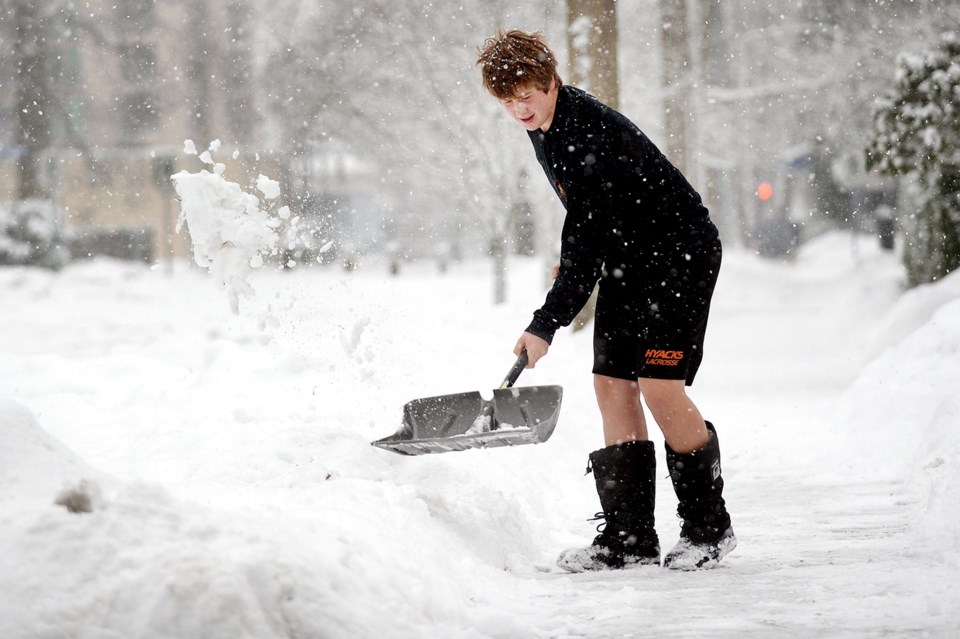Clearing streets and sidewalks of snow and ice isn’t cheap.
Dave Cole, the city’s assistant manager of engineering operations, said the city activated its snow and ice response plan in response to seven “significant” events where snow has accumulated on the ground: Dec. 5, 9, 11, 17, 18, 26 and 31. He noted that on Dec. 17 and 18, 40 centimetres of snow fell at the city’s works yard.
“It’s really tough to predict what is going to come,” he told council Monday night. “We often hear from the weatherman, like we did on Dec. 5 that we were going to get one centimetre, and ended up with 10. We have to be prepared to react to that.”
So far this season, the city has spent $386,000 on its snow and ice response plan: $236,000 on buying 2,300 tonnes of road salt; $16,000 on 655 tonnes of road sand; $28,000 on 400,000 on ice melt; and $106,000 for 1,900 hours of overtime. The city has also used 18,000 litres of brine.
The city’s response plan includes detailed routes for clearing city streets, sidewalks and facilities like Royal Columbian Hospital, care facilities and school zones. He said the primary response is to have bare asphalt on main routes, and once that goal is achieved crews move on to clear side streets in neighbourhoods, with lanes being the city’s lowest priority.
According to Cole, the city faced a few challenges with the type and number of winter events it’s had to respond to in the past month. These include: the time of snowfall (the first snowfall began at 5 a.m. so staff going into work early to start clearing roads were caught up in traffic); the day of snowfall (weekend snowfalls are when the city has the fewest employees at work); duration of snowfalls (most snow events in the region last a couple of hours and are followed by rain, but several of the recent snowfalls have gone on for quite some time); the holiday season (a time when some staff were on vacation or spending time with their family); and salt supply (which has been running short across the Lower Mainland.)
“This week we are looking at another arctic blast coming through with sub-zero temperatures,” Cole said. “We could see another snowfall event on the weekend.”
According to Cole, the city has dealt with more than 386 complaints, has issued 218 warning notices and 18 tickets. He said the city’s enforcement approach for this season has been more of an educational approach where we have gone out and tried to speak with merchants and residents about clearing sidewalks and making them aware of the city’s bylaw.
“We are working with them. Again, with the number of events, as long as the residents is making an attempt to clear the snow from the sidewalk then they haven’t been ticketed,” he said. “They receive warning notices. I know residents themselves are faced with an ice-melt shortage. They can’t go to the local hardware store and pick up a bag of ice melt to help break through the ice that has been building up.”
While there have been some criticisms of the city’s response to the snow and ice, Cole said the city has also received some positive feedback. He commended staff for the dedication they showed during all of these events, which included giving up their family time to come out and drive in some pretty bad conditions so they could help keep the city’s roads safe.
Mayor Jonathan Cote said the city last reviewed its snow response plan after the winter of 2008. Once the city gets through this winter, he said it will need to evaluate what’s been done right and how it can address some of the issues that have come up this winter.
Coun. Chuck Puchmayr suggested the city should look at the City of Calgary’s “snow and ice control clock” as a way of keeping community members informed of the city’s response to snow events. The clock, which appears on Calgary’s website, shows where the city is at in its seven-day response to clearing streets after a snowfall.
“This is a 50-year storm event, in my opinion,” he said of the recent snowfalls. “I certainly wouldn’t want us to have 400 pieces of snow equipment like Calgary does.”
Coun. Patrick Johnstone offered kudos to city staff for theirs efforts, but suggested the city needs to review its response plan to see how it can improve in the future.
“Some things have changed since 2009. The master transportation is a new plan. It sets a different set of priorities for transportation in the city,” he said. “I think we did an excellent job in the city managing the roads. The master transportation plan puts a higher priority on pedestrians and a higher priority on accessibility for our roads and our sidewalks.”
Coun. Bill Harper is puzzled by the attitude that “the snow is some sort of a calamity” as the weather was like this most of the winter when he was younger.
“That’s a part of our climate. Cleaning your sidewalk is not only part of your responsibility, but you are the one who chose to live here. Get out there and get it done,” he said. “You should enjoy the snow.”



